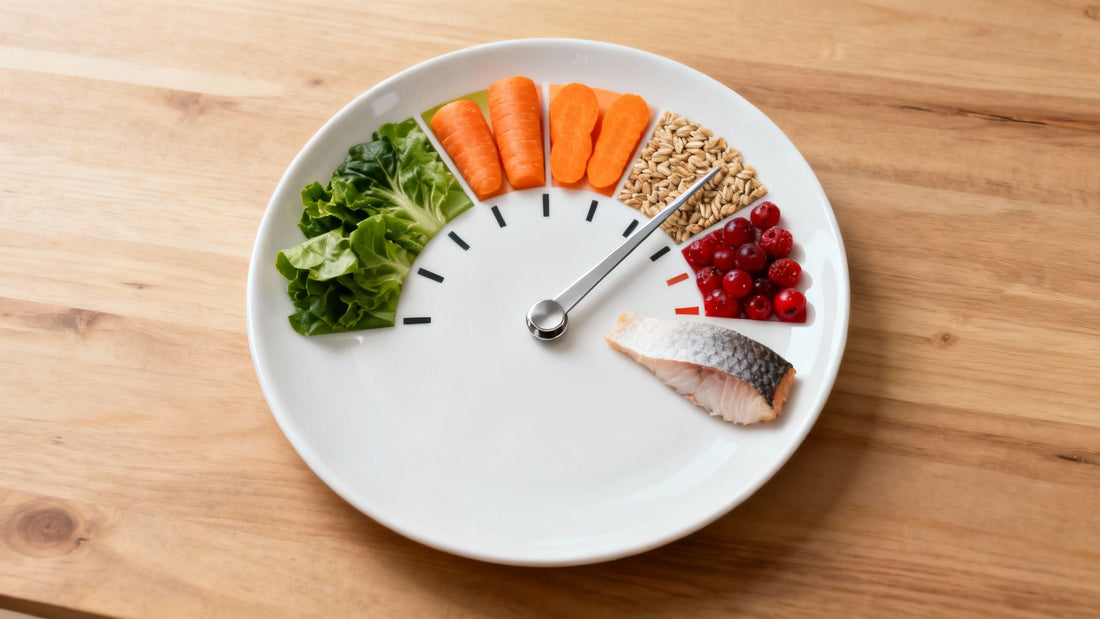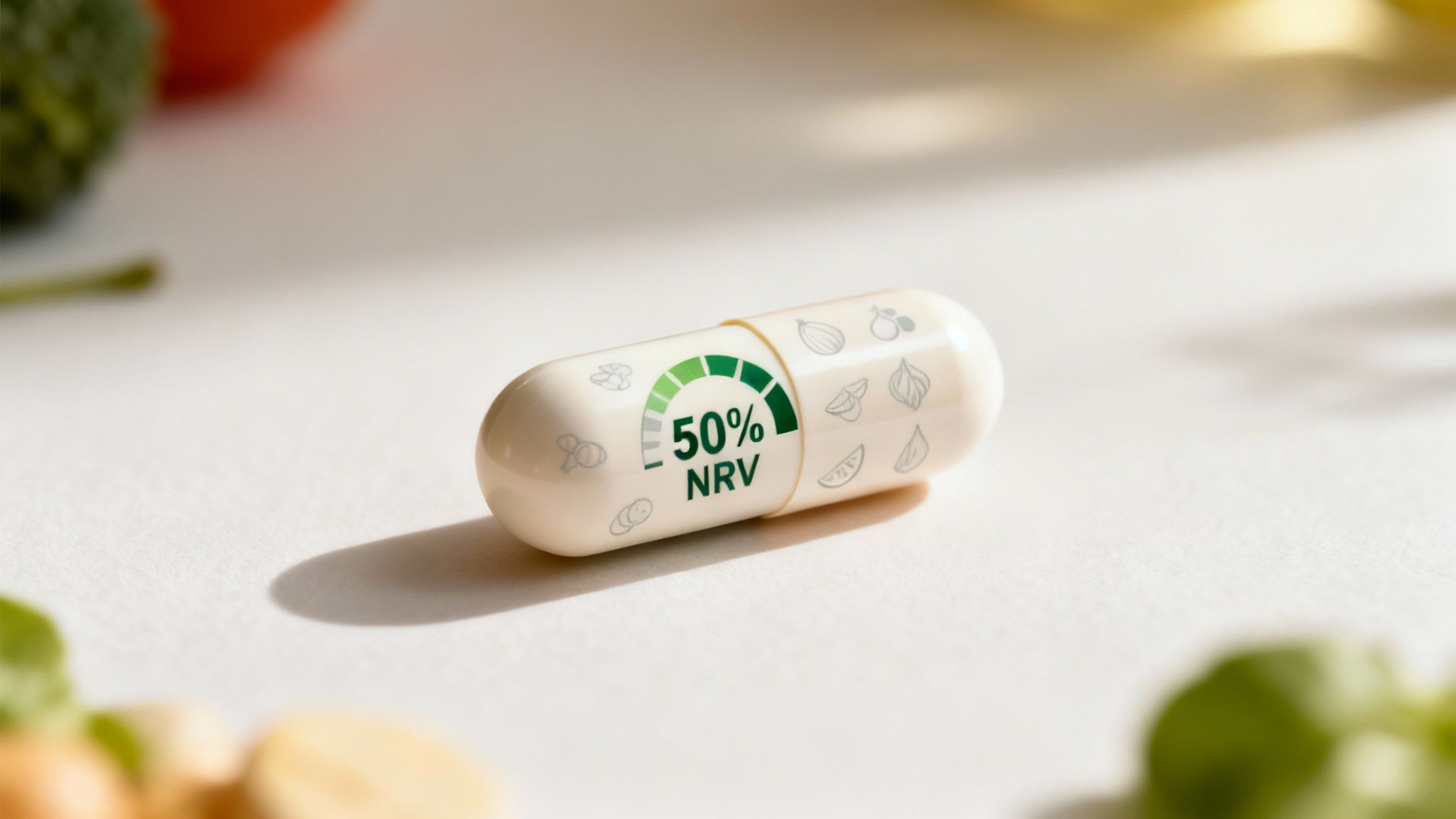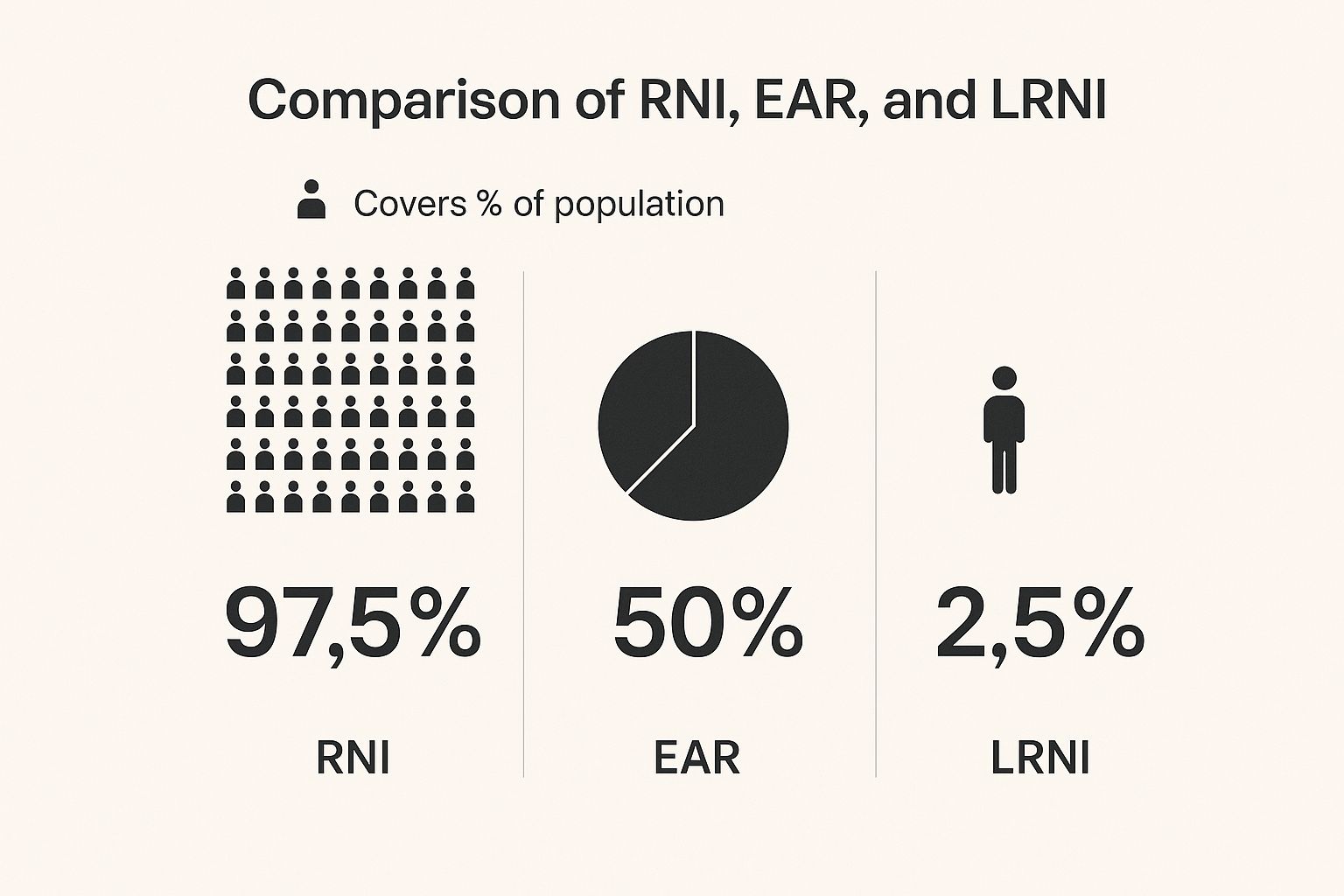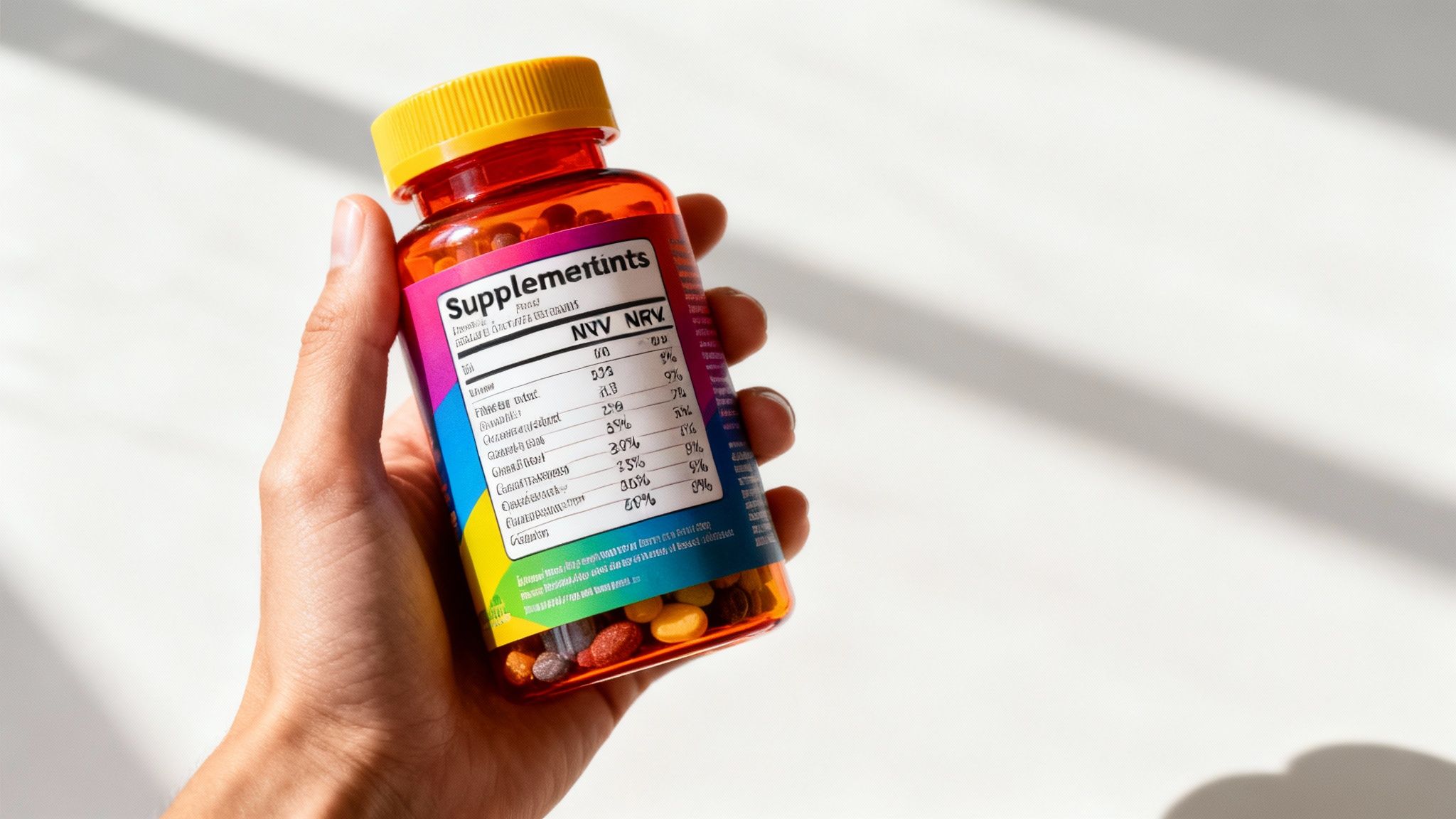
What Does Nutrient Reference Value Mean for Your Health?
Share
Ever glanced at a food label and felt a bit lost trying to figure out what ‘NRV’ actually means for you? You’re not alone. Think of the Nutrient Reference Value (NRV) as a handy benchmark—a daily nutritional target set for the average healthy adult. It’s there to give you a quick, at-a-glance idea of how much a serving of food or a supplement contributes to your daily needs for essential vitamins and minerals.
Your Quick Guide to Nutrient Reference Values

Imagine NRVs as the nutritional equivalent of a fuel gauge for your body. If a multivitamin serving provides 50% of the NRV for Vitamin C, it means you're getting about half the amount an average adult needs for the whole day from that single dose. This simple percentage makes it so much easier to track your intake and make smarter choices, whether you're focusing on gut health or cognitive performance.
It's important to remember, though, that these values aren't personalised prescriptions. They haven’t been tailored to your specific health goals, age, or lifestyle. Instead, they are standardised guidelines established for the general population across the UK and EU. Their main job is to help prevent widespread nutrient deficiencies by providing a clear, consistent reference point on all food and supplement packaging.
Why Do We Need NRVs?
The whole idea behind NRVs is to boil down complex nutritional science into a practical tool we can all use every day. Without them, we'd be left trying to make sense of a confusing jumble of milligrams (mg) and micrograms (mcg) with very little context. NRVs cut through that confusion, offering a universal percentage that’s instantly understandable.
This standardisation is vital for a few reasons:
- Empowers Consumers: It lets you quickly compare the nutritional content of different products, whether you’re choosing between breakfast cereals or deciding on a magnesium supplement.
- Promotes Public Health: By setting a baseline for nutrient intake, NRVs help guide food manufacturers in fortifying products and support public health goals aimed at preventing common deficiencies.
- Provides Clarity: They cut through the noise, giving you a straightforward answer to the question, "Is this a good source of this nutrient?"
The ultimate goal of the Nutrient Reference Value is to translate scientific data into a simple, actionable percentage. It helps you build a balanced diet by showing how each food or supplement contributes to your daily nutritional puzzle, piece by piece.
At the end of the day, getting to grips with what a nutrient reference value means is the first step toward reading labels with confidence and really taking control of your dietary choices.
The Science Behind UK Nutrition Guidelines
The Nutrient Reference Values (NRVs) you see printed on food labels aren't just numbers plucked from thin air. Think of them as the public-facing tip of a huge scientific iceberg, all designed to guide the nation's health. They’re the result of decades of research into what our bodies need not just to get by, but to thrive and fend off chronic diseases.
This whole system was created to give everyone—from health professionals to policymakers and the general public—a shared, evidence-based language for talking about nutrition. It brings a level of standardisation to public health advice that we can all understand.
The Three Pillars of UK Dietary Advice
Instead of one single, catch-all number for each nutrient, scientists came up with a much smarter system built on three core pillars. These values are designed to assess the needs of entire population groups, not just one person, which helps to explain what "nutrient reference value" really means in the real world.
This foundational framework was laid out back in 1991, introducing a structured approach to nutritional science in the UK. It gave us three key benchmarks: the Reference Nutrient Intake (RNI), the Estimated Average Requirement (EAR), and the Lower Reference Nutrient Intake (LRNI). For a deep dive into the original report that set these standards, you can find more information about the foundational dietary reference values for the UK.
This tiered system gives us a far more sophisticated way of looking at nutrition. It recognises that while there’s an average need, there's also a whole spectrum of requirements across the population—from the absolute minimum to prevent deficiency, right up to an amount that’s enough for almost everyone.
What Do These Tiers Actually Mean?
Each of these reference values has a specific job to do, a bit like different markers on a fuel gauge. Public health bodies use them to track dietary trends, plan menus for places like schools and hospitals, and decide on food fortification policies.
Here’s a simple breakdown of what each one means for you:
- Estimated Average Requirement (EAR): This is the midpoint. The EAR for a nutrient is the estimated average daily amount needed to meet the requirements of 50% of a healthy group of people. It's the peak of the nutritional bell curve.
- Reference Nutrient Intake (RNI): This is the one set to cover pretty much everyone. The RNI is the daily intake level that’s sufficient for 97.5% of the population. This is the value that most closely informs that single NRV you see on your multivitamin tub.
- Lower Reference Nutrient Intake (LRNI): Think of this as the safety net. The LRNI represents an intake so low it would be insufficient for most people, meeting the needs of only 2.5% of the population. Dipping below this level signals a real risk of deficiency.
When it all boils down, that single NRV on your omega-3 supplement or energy powder is a simplified, practical guide pulled from this comprehensive scientific system. It’s essentially a user-friendly application of the RNI, making sure the guidance is robust enough for the vast majority of healthy adults.
Decoding NRV, RDA, and Other Nutrition Acronyms
Trying to make sense of health information can sometimes feel like you’re swimming through an alphabet soup of acronyms. You'll spot NRV on a UK multivitamin label, then read about RDA in an American health article, leaving you wondering if they’re just different ways of saying the same thing.
While they all point towards the same goal of guiding healthy eating, these terms are definitely not interchangeable. Getting your head around the subtle but important distinctions is the key to correctly reading nutritional advice, no matter where it comes from. It empowers you to make smarter choices about your diet and supplements, whether you're looking at a mushroom blend in London or reading up on creatine research from the US.
A Global Guide to Nutrition Terms
So, what’s the big difference? It mostly boils down to geography and purpose. The NRV is a simplified, single value used for food labelling here in the UK and across the EU. Over in the US, however, they use a more detailed system for public health recommendations which includes several different values.
Here's a quick rundown of the main acronyms you're likely to bump into:
- RDA (Recommended Dietary Allowance): This is the American guideline. It represents the average daily intake needed to meet the nutrient requirements of nearly all (97–98%) healthy people. Unlike our single NRV, RDAs are often broken down by age, gender, and life stage (like pregnancy).
- AI (Adequate Intake): When there isn’t enough solid science to set a firm RDA, the AI comes into play. It’s an amount that’s assumed to be enough for nutritional adequacy, based on observations and estimations.
- UL (Tolerable Upper Intake Level): This one is a crucial safety marker. The UL is the maximum daily amount of a nutrient you can take that is unlikely to cause any nasty side effects. It’s a really important number to be aware of, especially when you’re taking high-strength supplements like magnesium or certain vitamins.
The infographic below gives you a great visual of the UK's tiered approach, showing how different values are set to cover the needs of different percentages of the population.

As you can see, the RNI (Reference Nutrient Intake), which is what informs the NRV on labels, is set deliberately high to make sure it covers the needs of almost everyone.
To make things even clearer, let's break down these terms side-by-side.
Comparing Common Nutritional Guidelines
This table compares the most common terms you’ll see on labels and in health articles, helping you quickly understand what each one means and where it applies.
| Term | What It Represents | Primary Application | Geographical Region |
|---|---|---|---|
| NRV (Nutrient Reference Value) | A single, simplified value for the daily intake of a nutrient. | Food and supplement labelling for the general adult population. | UK & EU |
| RDA (Recommended Dietary Allowance) | The average daily intake sufficient to meet the needs of 97-98% of healthy individuals. | Detailed dietary planning and public health recommendations. | USA |
| AI (Adequate Intake) | An estimated intake level used when an RDA cannot be determined due to insufficient evidence. | A guideline when scientific certainty is lower. | USA |
| UL (Tolerable Upper Intake Level) | The maximum daily intake of a nutrient unlikely to cause adverse health effects. | A safety ceiling to prevent nutrient toxicity. | USA |
Understanding these differences helps you contextualise the information you're reading, whether it's on a product label or in a research paper.
Putting It All Together
So, what does this all mean when you’re standing in the supplement aisle, trying to pick the right product?
A UK product that says it provides 100% NRV for zinc is designed to meet the needs of the vast majority of healthy adults, based on UK and EU standards. A US product, on the other hand, might state it contains 100% RDA for zinc, which could be a slightly different amount tailored to a specific group of people.
Think of it like this: NRV is the general user guide that comes with a product, designed to be clear and simple for everyone. RDA, AI, and UL are more like the detailed technical manual, offering specific data for different scenarios and users.
The main thing to remember is that while the goals are similar—preventing deficiencies and promoting good health—the numbers and the way they're used can vary. Knowing the difference between these terms makes you a much more savvy consumer. It allows you to understand what "nutrient reference value" truly means in a global context and apply that knowledge to your personal health journey.
Reading Food and Supplement Labels Like an Expert

This is where all that background knowledge becomes your personal superpower. It’s one thing to understand what a nutrient reference value means, but using it to make confident, practical choices in the supermarket aisle is the real goal.
The good news? Once you know what you’re looking for, scanning a label for the essentials takes just a few seconds.
The key column to zero in on is always the “% NRV”. This little percentage instantly tells you how much of your daily guideline for a nutrient is packed into a single serving. It cuts straight through the confusing milligrams and micrograms, giving you a clear, actionable number to work with.
Quick Rules for Label Reading
As a general rule of thumb, anything that provides 5% or less of the NRV per serving is considered a low source of that nutrient. On the flip side, a product is a high or significant source if it offers 15% or more of the NRV. This simple benchmark can completely change how you shop.
Let’s put this into a real-world scenario. Imagine you’re comparing two different omega-3 supplements, and you notice they both contain Vitamin D.
- Brand A: Provides 10% NRV of Vitamin D per capsule.
- Brand B: Provides 25% NRV of Vitamin D per capsule.
Using the 15% rule, you can immediately see that Brand B is a much more significant source of Vitamin D. That might be the deciding factor for you, especially during the darker winter months. This quick check helps you find better value and choose products that genuinely support your health goals.
Think of the NRV percentage as a filter. It helps you quickly sift through marketing claims and focus on what's actually inside the bottle, empowering you to compare different brands like a seasoned pro.
Putting NRVs into a Real-Life Context
The real art of using NRVs is seeing how they fit into the bigger picture of your entire diet. A percentage on a label doesn't exist in a vacuum; it’s there to complement the nutrients you’re already getting from whole foods.
For instance, you might see a magnesium supplement that proudly provides 100% of the NRV. That sounds perfect, doesn't it? But if your daily diet is already packed with magnesium-rich foods like spinach, almonds, and avocados, you might not actually need such a high dose from a supplement. Your total intake could easily end up being more than you need.
This is where smart supplementation comes in. You might decide a lower-dose magnesium supplement is a better fit, or perhaps you realise a high-quality women's multivitamin already covers your baseline needs. To learn more about what to look for, you can explore our guide on finding the right multivitamin for women.
Practical Tips for Everyday Use
Becoming an expert label reader is a skill you can build with a few simple habits. Here are some actionable tips to get you started:
- Look at Serving Sizes: The % NRV always relates to a specific serving size listed on the label. Make sure the amount you're taking actually matches what's on the packet.
- Prioritise Your Needs: Before you even look, identify which nutrients you want to focus on—maybe it's iron for energy or Vitamin B12 for cognitive support—and scan for those first.
- Don't Just Focus on Vitamins: Remember to check NRVs for essential minerals like zinc, selenium, and iodine. They're often overlooked but play vital roles in everything from hormone balance to immune function.
A great way to put your new label-reading skills into practice is by evaluating products like protein bars. A detailed guide on choosing the best protein bars for weight loss can offer the perfect opportunity to apply these principles. By turning abstract percentages into confident daily decisions, you take a massive step towards truly optimising your health.
Are We Meeting Our Nutrient Needs in the UK?
It’s one thing to have guidelines like NRVs, but it's another thing entirely to actually hit those targets with what we eat every day. So, how are we doing here in the UK? Honestly, the picture isn't as rosy as we'd like.
The National Diet and Nutrition Survey (NDNS), which keeps a close eye on the nation's eating habits, painted a telling picture between 2016 and 2019. The data revealed that many of us are consistently missing the mark on key nutrients. For instance, a staggering 90% of adults weren't eating enough oily fish, and many were falling short on fibre, vitamin D, and iron. You can see the full summary on the government's website here.
Key Dietary Shortfalls
Some nutrients seem to be consistently missing from our plates, which can really start to undermine our long-term health and wellbeing if we're not careful.
- Fibre: Most adults get nowhere near the recommended 30g per day. This gap can have a real knock-on effect on everything from digestion and gut health to heart health.
- Vitamin D: Intakes often drop below the 10µg target, especially during the darker winter months. That's a big deal for keeping our immune systems in good shape.
- Iron: A lot of women and teenagers find it tough to reach the 14.8mg daily guideline, which often explains why they feel so tired and run down.
- Fruit and Vegetables: It’s a classic for a reason. Over 70% of adults still don't manage the recommended 5 portions a day.
Nutrient Excesses to Watch
It's not just about what we're lacking; sometimes, the problem is getting too much of a good thing—or, more accurately, too much of a bad thing.
- Sugar: The average person consumes around 60g of sugar a day, which is double the 30g target based on NRVs. It’s a major driver behind rising obesity rates.
- Saturated Fat: At around 14% of our daily energy intake, most of us are eating more than the 11% NRV guideline, putting extra strain on our hearts.
- Sodium: High salt intake is a well-known contributor to high blood pressure, with many people regularly going over the 6g per day limit.
- Processed Foods: Relying too heavily on convenient, packaged foods can throw several NRVs completely out of balance in a single meal.
Bridging the Nutrient Gaps
While the data highlights a clear problem, it also points us towards a solution. You don't have to overhaul your entire life overnight.
Small, smart choices can make a huge difference. For example, starting your day with a fortified breakfast cereal can often deliver 20-25% of your NRV for iron or vitamin D in one bowl. Likewise, a well-chosen supplement, whether it's an omega-3 capsule or a mushroom blend for focus, can directly target any specific shortfalls you've noticed.
It’s all about creating a balanced approach. By planning meals around whole foods and strategically adding in enriched options, you can build a diet that's both varied and nutritionally complete. This way, you’re not just leaving your health to chance.
If you know you're struggling with fatigue, our guide on iron and B-12 supplement might be a good place to start. And if you're ready to get a clearer picture of your own diet, checking out the best food diary app options can be an incredibly powerful first step.
Paying attention to real-world nutrient trends bridges the gap between guidelines and daily choices.
Once you know where the average UK diet tends to fall short or go overboard, you can make much smarter decisions about your own food choices. Suddenly, supplements and fortified foods aren't just extras—they become strategic tools for filling the very real nutritional gaps that affect millions of people.
What Happens When Your Nutrient Intake Drops?

Consistently falling short of your Nutrient Reference Values isn't just about missing a target on a label; it has real, tangible consequences for how you feel and function every single day. Think of these micronutrients as the essential toolkit your body relies on for everything it does.
When your intake dips below those recommended levels, your body’s core systems start to feel the strain. You might notice your energy levels plummet, your immune system struggling to fend off every bug going around, or even a frustrating drop in focus and mental clarity. It's often a subtle decline, but one that chips away at your overall quality of life, affecting everything from your sleep to your stress levels.
The Problem With Modern Diets
Unfortunately, today's typical eating habits can make hitting these crucial nutrient targets a real challenge. In fact, studies are showing a pretty worrying trend of declining nutrient intake across the UK over the last couple of decades.
For instance, a 2019 dietary trends study flagged significant drops in several key micronutrients, including vitamin A, folate, and riboflavin. Most notably, vitamin D intake fell by a staggering 22% between 1999 and 2019, with calcium also on a steady decline. These trends are a serious concern, as NRVs were established precisely to prevent the kinds of deficiencies these drops can cause. You can dive into the findings from this HSIS dietary trends study for a closer look.
Widespread deficiencies in key nutrients like iron, magnesium, and B vitamins are directly linked to persistent tiredness and fatigue. Your body simply lacks the essential components needed for efficient energy production.
How Supplements Can Help Bridge the Gap
This is where supplements can play a really valuable role. They offer a practical and reliable way to fill the nutritional gaps between what your diet provides and what your body actually needs to function at its best. A high-quality multivitamin can act as a daily insurance policy, topping up your levels of essential vitamins and minerals.
For more specific issues, targeted supplements can be incredibly effective. If you’re constantly feeling drained, our guide on the best supplements for fatigue can help you pinpoint the key nutrients that might be missing. Whether it's a dedicated magnesium supplement to support energy metabolism, ashwagandha for stress, or an omega-3 capsule for cognitive health, supplements give you a direct route to ensuring your body has all the resources it needs to thrive.
Got Questions About Nutrient Reference Values?
Even after you get your head around what NRVs are, a few practical questions always seem to pop up when you start looking at labels. It’s completely normal. Let's walk through some of the most common ones so you can feel more confident in your choices.
Is It Okay to Go Over 100% of the NRV?
This is a brilliant question, and the answer really depends on the nutrient in question. For water-soluble vitamins, like Vitamin C and the entire B-vitamin family, your body is pretty smart; it usually just flushes out any excess it doesn’t need. This makes taking higher doses generally safe for most people.
But it’s a completely different ball game for fat-soluble vitamins (A, D, E, and K) and certain minerals like iron and zinc. Your body holds onto these, storing them in your tissues. Consistently taking too much can lead to them building up to harmful, even toxic, levels. That's precisely why health authorities also set a ‘Tolerable Upper Intake Level’ (UL)—think of it as a safety ceiling you really shouldn’t cross regularly from all your sources combined.
Do NRVs Apply to Absolutely Everyone?
In a word, no. This is a massive point to get clear on. The NRVs you see plastered on food packaging and supplement bottles are calculated for the average, healthy adult.
They are not one-size-fits-all and aren’t designed for:
- Children and infants
- Pregnant or breastfeeding women
- Older adults, whose ability to absorb nutrients can change
- Anyone with a specific health condition
These groups have very different nutritional needs that often require guidance from a doctor or registered nutritionist.
Think of the NRV on a label as a general road map for the average adult. It's a useful starting point, but it can't account for your unique journey, health status, or life stage. For that, you need a more personalised route planner.
Why Do Some Supplements Have Insane Percentages, Like 1000% of an NRV?
You’ve definitely seen it – a Vitamin B12 supplement boasting a sky-high percentage that seems almost ridiculous. So, what’s the deal? These high-potency formulas aren't just for general health; they're typically designed for specific, often therapeutic, purposes. For instance, someone with a diagnosed B12 deficiency needs a much bigger dose to get their levels back to normal. The same goes for a long-term vegan who can't get it from their diet.
Sometimes, these high doses are also used to achieve benefits beyond simply preventing a deficiency. The key takeaway is to understand why the percentage is so high and to always, always check with a healthcare professional before you start taking any high-strength supplement. They can tell you if it’s right, and safe, for you.
This article is for informational purposes only and is not medical advice. Always consult a qualified health professional before starting any new supplement or major lifestyle change.
